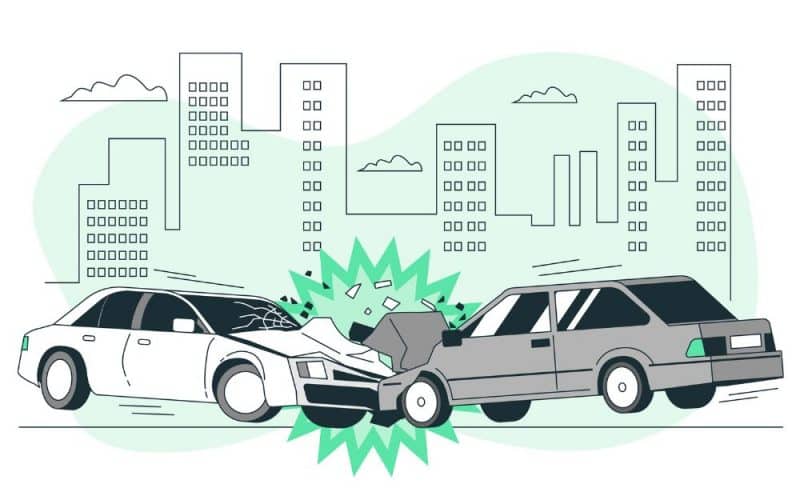If you have a less-than-perfect driving record, insurance companies may view you as a high-risk driver. This can make it harder to find affordable car insurance coverage. Drivers with accidents or serious traffic violations on their driving records can be considered high-risk drivers by car insurance companies.
Even someone with poor credit may be deemed high risk.
High-risk car insurance is more expensive than car insurance for experienced drivers or drivers with a clean motor vehicle record. Drivers considered high risk are young and inexperienced drivers or drivers that have one or more offenses on their record — such as a speeding ticket, an at-fault accident or a DUI.
Other driver profiles that are considered high risk are drivers with a lapse in coverage, certain types of car models or drivers with poor credit.
Who is a high-risk driver?
A high-risk driver is someone who’s considered more likely to file insurance claims than a typical driver. Insurance companies look at your driving record to determine how risky it would be to insure you and how much to charge you for coverage. Your insurer will classify you as either low or high risk based on factors such as whether you have DUI (driving under the influence) convictions, several at-fault car accidents or several traffic violations on your record.
High-risk drivers typically pay much more expensive car insurance premiums because providers view them as greater liabilities. Insurers also believe these motorists are more likely to make late payments or miss payments altogether.
It’s important to keep in mind that “high-risk driver” isn’t a legal designation, and the factors used to classify drivers as low or high-risk vary by insurer.
High-risk car insurance
High-risk car insurance typically isn’t much different than an average car insurance policy. The main difference is the driver and the price they pay for car insurance. High-risk drivers appear more likely to make claims in the eyes of car insurance companies and, therefore, have higher car insurance costs.
Cheap high-risk car insurance can be hard to find. It takes shopping around with the best car insurance companies to find the most affordable price.
Besides cost, another difference in high-risk car insurance is that it sometimes requires an SR-22 to be filed with the state to prove the driver has car insurance. The reason you need SR-22 insurance places you in a high-risk category with car insurance companies, not the SR-22 itself.
A state can require an SR-22 for various reasons, such as after a DUI conviction or being in an auto accident without car insurance. If you need an SR-22, you’ll want to compare shops only with car insurance companies that offer SR-22 filings. All of our top picks for high-risk car insurance file SR-22s.
Factors that make someone a high-risk driver
Car insurance companies examine many factors to determine how much risk you pose to them. You’re deemed a high-risk driver when you’re found more likely than most drivers to make a claim.
Certain driving and non-driving actions and issues lead auto insurance companies to see you as a high-risk driver, such as serious violations like a DUI, a history of auto accidents and claims, or even bad credit. Here are common factors that may make car insurance companies consider you a high-risk driver.
At-fault insurance claims
If you’ve made at-fault car insurance claims, insurers see you as someone who may take risky moves on the roadway, resulting in accidents and claims. That makes you a high-risk driver to car insurance companies.
Car insurance costs increase an average of 40% after an accident with injuries, according to Forbes Advisor’s research. That is over $800 more a year than a good driver with a clean driving record pays, according to our analysis of car insurance costs after an accident with injuries.
Car insurance prices increase an average of 38% after an accident with property damage. You’ll pay out around $776 more per year, on average, for auto insurance than a good driver, according to our analysis.
One minor accident may not affect your car insurance costs, especially if you have accident forgiveness coverage with your auto insurance company. And some car insurance companies don’t consider you a high-risk driver unless you’ve made multiple car insurance claims.
Speeding tickets
Car insurance costs increase 21% on average after a speeding ticket. That translates into paying over $400 more per year for auto insurance than a driver with a clean driving record.
Car insurance companies see speeding as risky behavior because if you get in an accident while speeding, odds are you’ll cause greater damage, resulting in higher claim payouts. An NHTSA report found that in 2020 speed contributed to 29% of fatal traffic collisions.
You’ll pay more for car insurance after a speeding ticket, but how much depends on if this was your first moving violation and how many miles over the limit you were going. Having multiple speeding tickets shows a pattern of riskier driving—and categorizes you as a high-risk driver.
DUI
Auto insurance costs increase 72% on average for drivers with a DUI, according to a Forbes Advisor’s analysis. The cost difference between a good driver with a clean driving record and a high-risk driver with a DUI is nearly $1,400 per year.
Car insurance costs after a DUI are so high because drivers under the influence present a significant risk of being in a serious accident. Being under the influence of alcohol can impair your judgment, coordination, and reaction times—all of which can vastly affect your abilities behind the wheel, making you more likely to be in an auto accident.
A study by the National Highway Traffic Safety Administration (NHTSA) found drivers with a breath alcohol concentration (BrAC) of 0.08 had around a four times greater risk of crashing than drivers with a BrAC of 0.00. The CDC notes that almost one in three traffic deaths in the U.S. involve a driver with a blood alcohol concentration of 0.08—the legal limit in most states—or higher.
Reckless driving
Auto insurance costs increase 61% on average after a reckless driving ticket, according to our analysis. Car insurance costs after a reckless driving ticket increase by over $1,000 per year on average, showing how seriously car insurance companies take this offense.
It can be hard to nail down what is considered reckless driving since its definition tends to vary by state. A common definition is driving your vehicle with a willful or wanton disregard for the safety of persons or property. In short, it’s driving dangerously and could result in a severe accident. This is why you’re labeled high risk if you have this offense on your driving record.
Credit
Car insurance prices increase 79% on average for drivers with bad credit, according to Forbes Advisor’s analysis. Our research finds that drivers with poor credit pay about $1,500 more per year than those with good credit.
Car insurance costs for drivers with poor credit run high because auto insurance companies assert that credit predicts the likelihood that a driver will make a claim. Drivers with bad credit are seen as having a higher chance of filing claims, so they’re considered a higher risk to insure—in most states.
California, Hawaii, Massachusetts, and Michigan have banned using credit when setting car insurance prices.
Location
If the area you live in sees many claims, your location can bump you into a higher-risk category with car insurance companies.
For instance, if you live in a congested urban area prone to more car crashes or an area with a high rate of car theft, vandalism or even severe weather, those things can result in a higher-than-average rate of claims and make you risker to insure.
For instance, Florida is prone to severe weather, like hurricanes, and its average price of car insurance is over 300% more expensive than Idaho, which has milder weather.
Age
Auto insurance companies consider some drivers high risk because their age group tends to be in more accidents and file claims than others. Generally, teenagers and seniors pay more for car insurance than drivers of other ages.
Auto insurance costs increase 92% on average for parents adding a 16-year-old driver to their policy, according to our evaluation of annual teen car insurance prices. An 18-year-old on their own policy pays 150% more a year on average for car insurance than a 25-year-old driver, according to our analysis.
Teen drivers are young, inexperienced and more likely to crash, so they pay higher car insurance costs. The fatal crash rate per mile driven for 16 to 19-year-old drivers is nearly three times the rate for drivers aged 20 or over, according to the Insurance Institute for Highway Safety (IIHS).
The IIHS sees a notable increase again in fatal crashes among drivers ages 70 to 74 and the highest with drivers age 85 and older. Senior drivers aged 70 and older are experienced, but reaction times are slower, and they’re more susceptible to injuries causing them to be assessed as higher risks.
Car insurance prices are 34% higher on average for a senior driver aged 80 compared to costs at age 60, according to our analysis of annual auto insurance costs.
Due to state laws, age is not a factor in calculating auto insurance costs in California, Hawaii, or Massachusetts.
Best car insurance companies for high-risk drivers based on driving record
Travelers is the best widely available car insurance provider for high-risk drivers, with solid scores in financial stability, customer satisfaction and essential coverages.
USAA is a close contender, but its policies are only available to drivers in the military community. Besides having affordable rates, it also received excellent financial stability and customer service scores.
| Company | Annual Premium | Total Score | Affordability | Customer Satisfaction | Claim Satisfaction | Financial Stability |
|---|---|---|---|---|---|---|
| USAA | $1,569 | 80 | 5.00 | 4.95 | 2.50 | 5.00 |
| Travelers | $1,951 | 63 | 2.00 | 3.57 | 2.50 | 5.00 |
| State Farm | $2,023 | 56 | 1.44 | 3.91 | 2.10 | 5.00 |
| Allstate | $1,994 | 56 | 1.67 | 3.20 | 1.90 | 4.00 |
| Nationwide | $2,103 | 53 | 0.81 | 2.99 | 2.40 | 4.00 |
| Farmers | $2,139 | 52 | 0.53 | 3.37 | 2.30 | 3.00 |
| Progressive | $2,184 | 52 | 0.18 | 3.27 | 2.40 | 4.00 |
| GEICO | $2,207 | 50 | 0.00 | 3.74 | 2.20 | 5.00 |
Cheapest car insurance companies for high-risk drivers based on driving record
High-risk car insurance doesn’t come cheap — the average cost of auto insurance for a 40-year-old driver with an at-fault accident on their record is $2,021 per year, but a safe driver only spends $1,030 for the same coverage. Fortunately, drivers with violations on their driving records can find affordable auto insurance options.
Travelers is the least expensive widely-available auto insurance for high-risk drivers, with an annual average premium of $1,951. USAA is a close second since a policy costs $1,569 per year. However, only drivers affiliated with the military can purchase them.
| Company | Annual Premium |
|---|---|
| USAA | 1,569 |
| Travelers | 1,951 |
| Allstate | 1,994 |
| State Farm | 2,023 |
| Nationwide | 2,103 |
| Farmers | 2,139 |
| Progressive | 2,184 |
| GEICO | 2,207 |
Cost of car insurance for high-risk drivers based on driver profile
When most people consider which factors indicate a high-risk driver, they think about many of the ones we already covered: a poor overall driving record or a violation, such as an at-fault accident or a DUI. However, insurance companies may decide you pose a high risk because of factors unrelated to your driving record.
Young drivers who recently received their license, for example, pay substantially more than their older counterparts. Drivers with bad credit scores are also considered high risk because insurers believe there’s a greater chance they may not keep up to date with their payments. It may also be more challenging to find cheap car insurance for students since they have less driving experience.
The type of vehicle you drive also plays an important role, too. If you drive a car with a top safety rating, such as a Volvo or Subaru, you’re far less likely to pay higher premiums than someone driving a sports car.
Cost of high-risk car insurance: Young drivers
Car insurance providers typically view students and teen drivers as high-risk drivers since they have less experience behind the wheel and higher accident rates than more experienced drivers, leading to a significant difference in insurance costs. For example, an 18-year-old driver has an average premium of $3,956 per year. In contrast, the average rate for a 40-year-old driver is $1,220.
Finding cheap car insurance for teens isn’t impossible, but you need to know where to look. Signing up under a parental policy helps young drivers save on car insurance, and in most cases, it is illegal for a teen under 18 to purchase auto insurance without an adult co-signer.
Also, many insurers offer lower rates for maintaining good grades and driving vehicles with a low-risk rating.
Cost of high-risk car insurance: Drivers with poor credit
Your credit score may affect insurance costs since insurers assume a correlation between poor handling of credit and an increase in the number of claims filed. Having bad credit can make finding reasonably-priced car insurance more challenging. On average, drivers with poor credit standing pay $2,260 more in car insurance per year, nearly three times as much as those with good credit scores.
However, you can still find cheap car insurance with poor credit. Taking steps to improve your credit, such as minimizing debt and making on-time payments, may help lower your insurance costs.
Cost of high-risk car insurance: Drivers with sports cars
Data shows that sports cars are more commonly stolen, causing some insurers to charge higher premiums. Also, because sports cars weigh less and are smaller than a standard sedan, they tend to sustain greater damage when involved in a wreck.
For example, a common sports car model that is relatively expensive to insure is a Ford Mustang. According to latest research, drivers with a 2010 Ford Mustang paid an average of $204 more than those who owned a Toyota Camry of the same model year. Those driving a 2020 Mustang paid roughly $894 more.
How to avoid being categorized as a high-risk driver
Whether you’re already classified as a high-risk driver or want to avoid falling into that category, you can take steps to keep your car insurance low.
Drive safely
It may seem intuitive, but ensuring you don’t get speeding tickets or cause wrecks can go a long way in helping you pay lower rates for auto insurance. Follow the speed limit and all posted signage. If you have violations already on your motor vehicle record, shop for new rates as violations age out of the rate-setting process, typically after three years.
Improve your credit score
Making on-time payments, adding your name to a parent’s or family member’s utility bill and keeping your credit card balances low can all help improve your credit score. It can take some time, but the payoff is worth it.
Take a defensive driving course
Many insurance companies offer discounts to those who complete a defensive driving course. In addition to curbing risky behaviors, these programs also help you identify driving dangers more quickly.
Recommended Articles
- Nissan Car Insurance: Average Cost & How To Get It
- Grundy Classic Car Insurance: Coverage, Cost & Review
- State Farm Classic Car Insurance Review: Cost & Coverage
- Best Car Insurance for New Drivers
- Car Insurance With No License: Can You Get It & How?
- Car Insurance Renewal: How Does It Work?






